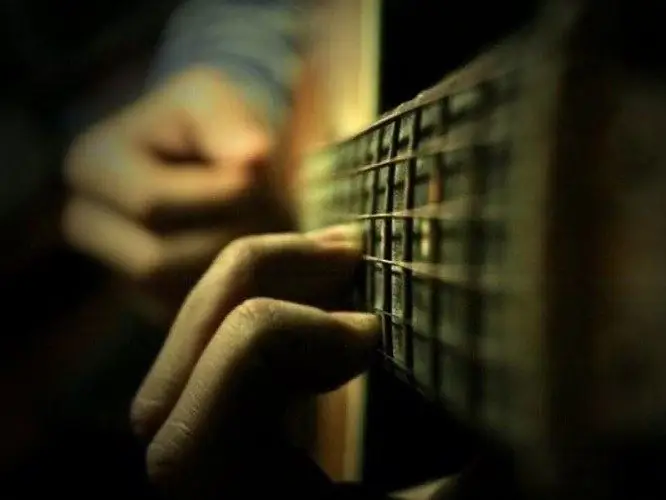The main ways of playing the guitar are fighting and busting. The striking is suitable for the rhythm guitar part, and the ability to pluck the strings allows you to play beautiful solos. Before learning this technique, it's worth deciding if you want to play with your fingers or use a pick.

Instructions
Step 1
The difference between playing with your fingers and a pick lies in the degree of difficulty and sound. As a rule, fingering with your fingers is more convenient and therefore somewhat easier than with a pick. But on the other hand, the pick allows you to produce a sonorous and longer and clearer sound. For playing with the pick, the correct position of the right hand is important. Place your wrist on the sounding board over the clipper and hold the pick between your thumb and forefinger. When playing from the sixth string to the first, the pick should touch the string from top to bottom, and vice versa from the first to the sixth string. To make it easier for you to play, use soft, thin picks that will glide smoothly over the strings without clinging to them.
Step 2
The position of the wrist when playing with the fingers is the same as when playing with a pick. The fingers themselves are located each on its own string. The big finger is usually responsible for the sixth and fifth, the index finger is for the fourth, the middle one is for the third, the unnamed one is for the second, and the little finger is for the first string. For some tunes that do not use the sixth, fifth, or first strings, the position of the fingers may move up or down, respectively. When playing, the thumb hits the string from top to bottom, and the rest - vice versa.
Step 3
After you get used to the correct positioning of the hand, you can begin to pluck the strings. All busting is divided into two types: simple, in which the strings are twitched in a row (for example, 6, (5), 4, 3, 2, 1, 2, 3, 4, (5), etc.), and complex, in which the strings alternate (for example, 5, 3, 2, 3, 1, 3, 2, 3). There are a lot of types of simple and complex enumeration. Above, there were two of the most common ones.
Step 4
Learning to brute force is best starting with simple exercises. To do this, pull the open strings one at a time from top to bottom and back again. After the movement of the fingers reaches automatism, and they move independently of each other, you can begin to put chords and move on to complex fingering. A simple exercise can help you learn to move your fingers independently of each other (for example, keeping your little finger in place when you move your ring finger). Place your palm on the table and lift one finger at a time from the surface, trying to hold the rest in place. First, move from thumb to pinky, then back, then alternate fingers. Exercise as much time as possible and then you can learn to play the guitar pretty quickly.






